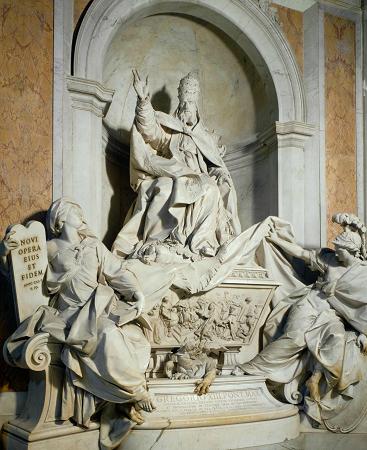Pope Gregory XIII (1502 - 1585). Pope Gregory XIII, born Ugo Boncompagni, was head of the Catholic Church and ruler of the Papal States from 13 May 1572 to his death in April 1585. He is best known for commissioning and being the namesake for the Gregorian calendar, which remains the internationally accepted civil calendar to this day. Youth Ugo Boncompagni was born the son of Cristoforo Boncompagni and of his wife, Angela Marescalchi, in Bologna, where he studied law and graduated in 1530. He later taught jurisprudence for some years, and his students included notable figures such as Cardinals Alexander Farnese, Reginald Pole and Charles Borromeo. He had an illegitimate son after an affair with Maddalena Fulchini, Giacomo Boncompagni, but before he took holy orders, making him the last Pope to have left issue. Career before papacy At the age of 36 he was summoned to Rome by Pope Paul III, under whom he held successive appointments as first judge of the capital, abbreviator, and vice-chancellor of the Campagna e Marittima. Pope Paul IV attached him as datarius to the suite of Cardinal Carlo Carafa. Pope Pius IV made him Cardinal-Priest of San Sisto Vecchio and sent him to the Council of Trent. In the year 1552, Ugo Boncompagni confirmed the paternity of his son Giacomo. As stated in the online Archivio Digitale Boncompagni Ludovisi: One of the most valuable items to emerge from the new archival finds from the Villa Aurora is an autograph declaration in Latin and Italian dated 22 December 1552 by Ugo Boncompagni. Here Ugo confirms his paternity of Giacomo Boncompagni by Maddalena de' Fucchinis, a servant in the employ of his sister-in-law Laura Ferro. The future Pope explains in detail the circumstances of the boy's conception, which took place in 1547 in Bologna after the Council of Trent had moved to that city; his motive was to assure his inheritance rights following the death of his father Cristoforo Boncompagni. He also served as a legate to Philip II of Spain, being sent by the Pope to investigate the Archbishop of Toledo Bartolomo Carranza. He formed a lasting and close relationship with the Spanish king, which aided his foreign policy aims as Pope. After Pope Pius V died, the conclave chose Cardinal Boncompagni, who assumed the name of Gregory XIII in homage to Gregory the Great, a 6th-century reforming pope. It was a very brief conclave, lasting less than 24 hours. Many historians have attributed this to the influence and backing of the Spanish king. Charles Borromeo and the cardinals wishing reform accepted Boncompagni's candidature and so supported him in the conclave, while the Spanish faction also deemed him acceptable due to his success as a nuncio in Spain. Reform of the Church Portrait of Gregory XIII by Lavinia Fontana Once in the chair of Saint Peter, Gregory XIII dedicated himself to reform of the Catholic Church. He implemented the recommendations of the Council of Trent. He mandated that cardinals reside in their sees without exception, and designated a committee to update the Index of Forbidden Books.
more...




